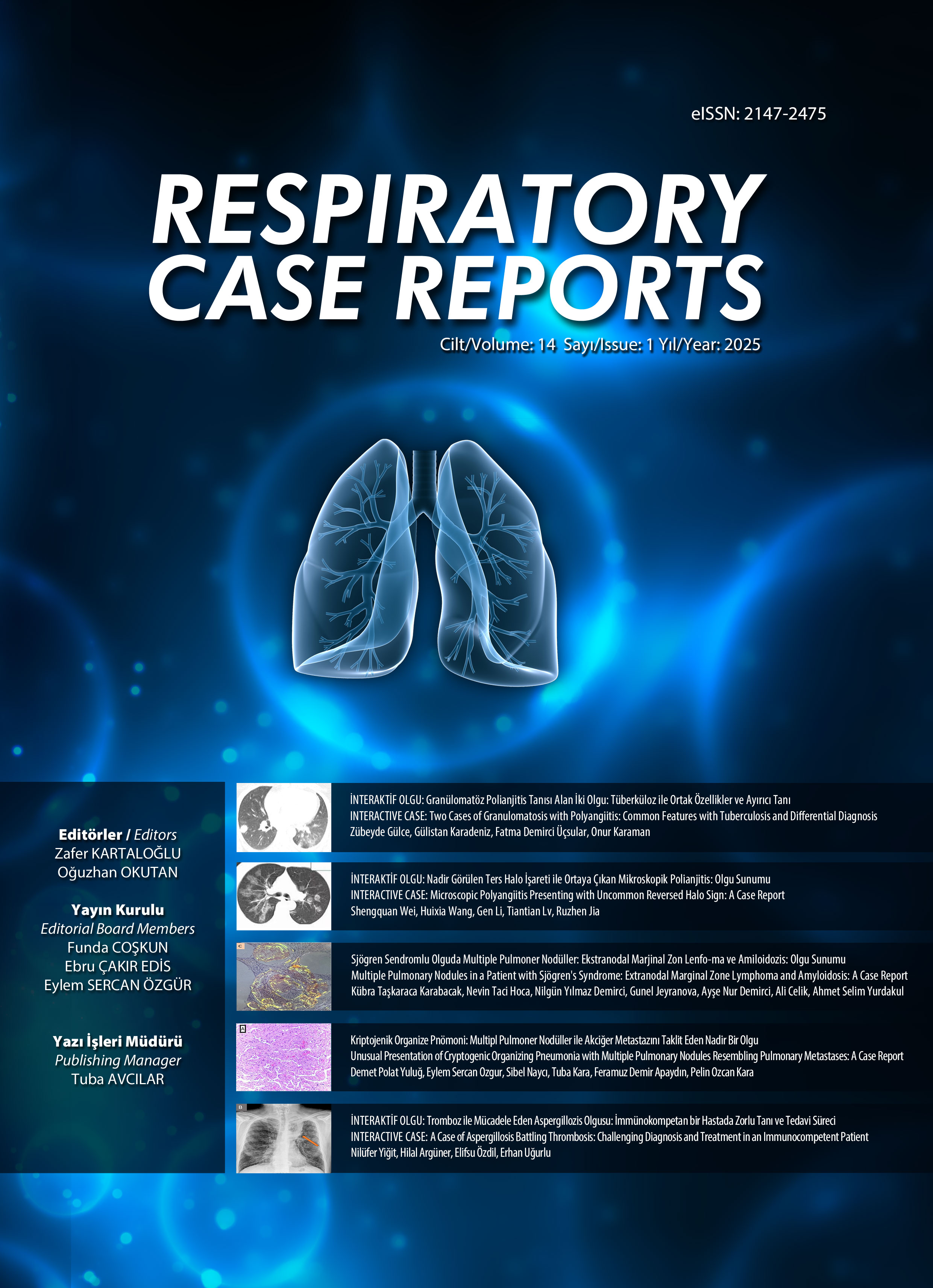e-ISSN 2147-2475

Volume: 12 Issue: 2 - June 2023
| CASE REPORT | |
| 1. | Re-expansion Pulmonary Edema following Medical Thoracoscopy in Patients with Tuberculous Pleural Effusion Nai Chien Huan, Khai Lip Ng, Hema Yamini Ramarmuty, Kasuma Mohamed Nordin, Kunji Kannan Sivaraman Kannan doi: 10.5505/respircase.2023.04207 Pages 40 - 45 Medical thoracoscopy (MT) procedures are witnessing increased use worldwide as a minimally-invasive modality offering simultaneous diagnostic and therapeutic benefits to patients with unexplained pleural effusions. Re-expansion pulmonary edema (REPE) is a rare but potentially life-threatening complication associated with pleural effusion drainage that can happen following MT. Little is known about the incidence, risk factors or management strategies of REPE post-MT. We report here on the largest case series to date involving three patients with tuberculous pleural effusion (TPE) who developed REPE after MT. All three patients responded well to supportive measures, including oxygen therapy, intravenous diuretics and hydrocortisone. We believe this case series and literature review serve to highlight an uncommon but dan-gerous complication of MT. Early recognition, fol-lowed by prompt treatment of REPE can ensure a better clinical outcome. |
| 2. | Pulmonary Nocardiosis Mimicking Pulmonary Tuberculosis in an Immunocompetent Patient Diagnosed by Cytology of Bronchoscopic Lavage Hülya Abalı, Efsun Gonca Uğur Chousein, Derya Hırçın Cenger, Neslihan Fener doi: 10.5505/respircase.2023.57983 Pages 46 - 49 Nocardia infections are common in immunocompromised and organ transplant patients, although Nocardia species only rarely cause infections in immunocompetent patients. Pulmonary nocardiosis is the most common clinical manifestation of Nocardia species, and may imitate several pulmonary diseases, such as pulmonary tuberculosis (TB) in such high-risk settings for TB as Türkiye. We present here a rare case of an immunocompetent patient with pulmonary nocardiosis mimicking tuberculosis in terms of the history, clinical symptoms and radiological findings. Acid-fast staining and real-time polymerase chain reaction testing of the bronchoscopic lavage were negative for TB, and no Mycobacterium species proliferated in the culture. Two similar diseases were differentiated by lavage cytology. The patient improved dramatically following a short course of treatment over two months. |
| 3. | Thoracal Sympathectomy in Buerger's Disease: A Case Report Bahar Ağaoğlu Şanlı, Serkan Yazgan, Ahmet Ucvet, Şaban Ünsal doi: 10.5505/respircase.2023.04706 Pages 50 - 53 Thromboangiitis obliterans (Buerger's disease) is an inflammatory disease that affects small and medium-sized vessels in the upper and lower extremities, and is frequently seen in young smokers. It is character-ized by ischemia, necrosis, finger ulcers and pain in the distal extremities due to vascular inflammation and thrombosis. A thoracic sympathectomy was per-formed to provide vascularization to a 47-year-old patient with a diagnosis of Buerger's Disease who had ulcers and pain in a distal extremity that did not resolve despite medical treatment. Since it is a rarely used method in the treatment of Buerger's Disease, we wanted to present our experience in the light of the literature. |
| 4. | Lupus Anticoagulant Autoantibody Positivity Due to Rivaroxaban: A Case Report Erol Başaranoğlu, Şükran Aslan, Abdurrahman Şenyiğit, Mehmet Orhan Ayyıldız, Hadice Selimoğlu Şen doi: 10.5505/respircase.2023.04764 Pages 54 - 56 Pulmonary embolism refers to obstructions of the pulmonary arterial bed due to various etiologies. In most cases, pulmonary embolisms are caused by blood clots that travel to the lungs from the deep veins in the legs or, more rarely, from veins in other parts of the body. Today, the new generation oral anticoagulants are preferred for the treatment of pulmonary embolism due to their ease of use and greater reliability. The new oral anticoagulants are novel direct-acting medications that are selective for a specific coagulation factor, either thrombin or activated factor Xa, among which Rivaroxaban has been used in many countries. Lupus anticoagulant autoantibodies are considered a common culprit in the etiology of pulmonary embolisms with no underlying risk factor, which may lead to false positives in patients using Rivaroxaban. A case with lupus anticoagulant autoantibody positivity due to rivaroxaban usage is presented here to draw attention to this issue. |
| 5. | A Rare Side Effect of Pirfenidone: Lichenoid Actinic Keratosis and Lichenoid Actinic Mucositis Berna Akıncı Özyürek, Tuğçe Şahin Özdemirel, Esma Sevil Akkurt, Kerem Ensarioğlu, Barış Akgül doi: 10.5505/respircase.2023.04880 Pages 57 - 60 Pirfenidone is one of two approved treatments for Idiopathic pulmonary fibrosis (IPF), the most common side effects of which are related to the skin and the gastrointestinal tract. Although these side effects are well tolerated, it may at times be necessary to discontinue the drug. We present here a case with rare side effects of pirfenidone treatment, lichenoid actinic mucositis and lichenoid actinic keratosis. A 72-year-old male patient with complaints of dyspnea and dry cough was diagnosed with IPF with typical radiological findings, and was followed up for three years. The patient was considered stable under pirfenidone treatment, however, skin lesions were observed on the scalp and lip at the third-year follow-up, a biopsy of which revealed the presence of lichenoid actinic mucositis and lichenoid actinic keratosis. The lesions regressed upon the cessation of pirfenidone, but returned after the reinitiation of treatment, and the precancerous nature of the lesions spurred a change of treatment to nintedanib. |
| 6. | Lung Carcinoma with Orbital Metastasis: Two Cases İlker Yılmam, Ebru Çakır Edis, Serdar Solak, Hande Güçlü doi: 10.5505/respircase.2023.80037 Pages 61 - 64 While metastases of the lung, liver, adrenal glands, skeletal system and cranium can frequently be detected at the diagnosis stage of lung cancer, as the primary cause of cancer-related death around the world, orbital metastases are less frequently observed. Metastatic orbital masses account for 37% of all orbital tumors, while the most common tumors that metasta-size to the orbit are those affecting the prostate, breast and lung. Despite advances in diagnostic methods over the years, orbital metastases are often overlooked, and diagnosis can be difficult. Radiological imaging methods are highly important for the evaluation of metastasis. Orbital metastases were identified on magnetic resonance imaging (MRI) in both patients in the present study, both of whom developed visual impairment after being diagnosed with primary lung cancer, and were not considered for diagnostic invasive interventions due to the primary disease. Underlying neoplastic diseases should be considered during differential diagnoses of visual disturbances. |
| 7. | Clear Cell Sugar Tumor of The Lung Hülya Şahin, Seda Bingöl doi: 10.5505/respircase.2023.19577 Pages 65 - 69 Clear cell tumors of the lung are extremely rare neoplasms, and only a limited number of cases have been reported in literature to date. It is an atypical and mostly benign peripheral primary lung tumor belonging to the family of perivascular epithelioid cell tumors, and is referred to also as a sugar tumor since it consists of clear cells containing intracytoplasmic glycogen. The case presented here was diagnosed with a clear cell sugar tumor of the lung during the pandemic, but died due to COVID-19 pneumonia before surgery. |
| 8. | A Case of Cerebro-pulmonary Mucormycosis Associated with COVID-19 Burcu Ozdemir, Levent Özdemir, Savaş Gegin, Ömer Serdar Bekdemir, Hakan Polat, Seda Koç Şahin doi: 10.5505/respircase.2023.57778 Pages 70 - 74 Mukormikoz COVID-19 hastalığı sonrası tüm dünyada yaygın olarak gözlenen ve yüksek ölüm oranına sahip fungal bir enfeksiyondur. Olgumuz 55 yaşında hemoptizi şikayeti olan, özgeçmişinde COVID 19 nedeni ile yüksek doz ve uzun süreli kortikosteroid kullanımına bağlı kontrolsüz diyabet öyküsü olan ve vorikanazol tedavisi kullanırken gelişen, lipozomal Amfoterisin-B ve oral posakonazol ile medikal tedavi uygulanan, sonrasında cerrahi olarak çıkarılan ilk serebro-pulmoner mukormikoz olgusudur. |
| 9. | Life-threatening Hemorrhagic Conditions in COVID-19 Patients in the Intensive Care Unit: A Case Series Hatice Kutbay Ozcelik, Nazan Beyhan, Esra Akkutuk Ongel, Özkan Devran doi: 10.5505/respircase.2023.37268 Pages 75 - 80 The COVID-19 pathology is characterized by thromboinflammatory events at a microvascular level in the lung and other organs. In an assessment of patients with severe COVID-19 pneumonia requiring intensive care, we identified cases in which life-threatening hemorrhage was encountered after the administration of therapeutic/prophylactic-dosage low molecular weight heparin according to guidelines. Among the identified cases, three were male, two female and all patients were administered anticoagulation admin-istrations. All patients with suspected bleeding were identified with severely low hemoglobin levels. Retroperitoneal hematomas were detected in four of the five patients, one of whom was diagnosed based on clinical suspicion, while others were confirmed via imaging. One patient died due to hemorrhage, while the hemorrhages of other patients were controlled through the discontinuation of anticoagulant therapy and appropriate blood product transfusions. While administering anticoagulant therapy for COVID-19 pneumonia in patients followed in the intensive care unit, attention should be paid to the issue of bleeding, and the potential for such rare but life-threatening complications as retroperitoneal hematoma. |












